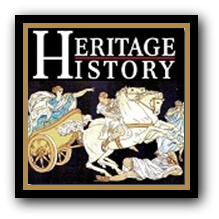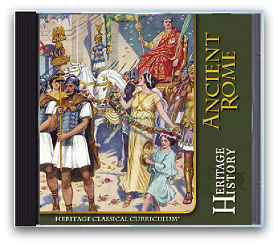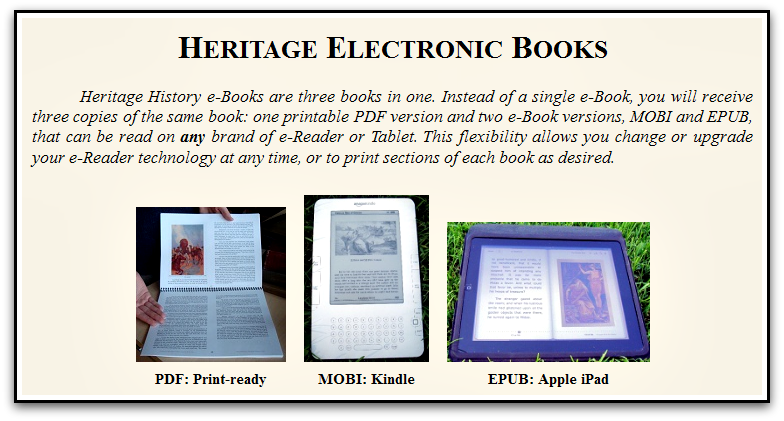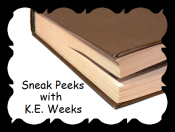
Ever since purchasing a Kindle, I’ve been looking for ways to utilize it in our homeschool. Of course, as many e-reader owners have discovered, there are plenty of free resources out there. Websites such as
Project Gutenberg keep e-reader users happily loading up their device with free reading material.
I now have many classical histories on my Kindle that could easily be integrated into our history studies. The problem is, I don’t always know the best way to go about that.
Heritage History, a history curriculum using classical titles, has taken much of the legwork out of utilizing these great resources in your homeschool.
I was sent the
Ancient Rome Classical Curriculum on CD for this review. Adaptable for most ages, this history curriculum includes 45 completely illustrated books, over 60 maps, timelines, battle dictionaries, reading recommendations, geography terms, short biographies, historical era summaries, and study guide resources.

All of the books are available in their entirety for viewing and reading on the Heritage History website, though there is a small fee to individually purchase titles as a download. While all of the titles included are public domain and available for free elsewhere as well, the value in this curriculum is in both the Study Aids and the convenience and organization of the titles, which are provided on the CD in two downloadable formats.
The titles in the library are easily organized by reading level. Included are 8 introductory, 16 intermediate, and 21 advanced level titles. Titles can also be organized by genre, summaries, and series to help users locate appropriate titles to read. For example, the genre categories include: Comprehensive History, Episodic History, Biography, Christian Antiquity, Legends and Literature, Historical Fiction.
Once I found the title I wanted, getting the e-book on my Kindle was very easy. Directions for transferring the available MOBI or EPUB files (both are included on the CD) to various devices are provided. If you don’t own a reader, titles can be read on the computer or printed.

Worth mentioning is the easy navigation of all the resources on the CD. While you do not need an internet connection to use the CD, web browser tools are utilized to organize all of the information in a familiar website presentation. One of the things that frustrates me about digital products is I always feel like I’m scrolling through pages trying to find information. I really appreciated having a sidebar menu with categories and use of familiar browsing tools.
The curriculum does not provide an assignment schedule of readings nor learning activities, but rather groups related readings, characters, and events and provides age specific core reading recommendations. This falls in line with the interest-driven history study approach of the curriculum. The
Curriculum User Guide provides detailed information on Heritage History’s particular living books approach, their philosophy and structure of the curriculum, and recommendations for history study. Below you will also find samples of each of the Study Aids provided to users.
While the curriculum as designed to serve the needs of a wide age range, the focus is on intermediate and general-interest readers. There only a few titles below the 4th grade level and no analytical texts at the college level. However, younger children could be read the titles aloud, and overall the program is designed to be quite flexible to work for many ages and approaches.
The recommended weekly time to go through the program is 3 hours per week. There are worksheets, busywork projects, or concrete assignments. The guideline is to have each student read the core selections, at least three supplemental books for depth, and three or so substantial free-choice books over the course of the year.
Developed with a focus on providing a strong library of resources rather than another core curriculum, Heritage History encourages use of their program as a resource for other traditional history programs. Some of those specifically mentioned that would work well with Heritage History include Ambleside, OId Fashioned Education, Living Books, Tapestry of Grace, Story of the World, and Veritas/Omnibus.
The Study Aids on the CD are also available separately in both printed and downloadable versions as a Study Guide. The PDF version of the Study Guide is identical to the resources on the CD, so
there is no need to purchase a separate Study Guide if you own the curriculum CD. Its availability is for those families who would prefer to read the recommended books directly from the Heritage History webpage or purchase individual books.
Overall, I feel Heritage History is a well-organized, easy-to-use, and value-priced history curriculum. I love that everything comes on a CD, rather than being required to download to my hard drive. My son enjoyed taking my Kindle off to a cozy corner for his history studies, so there were no complaints on the student end either!
Heritage Classical Curriculum CDs are available for $24.99. The
Study Guides are available in color print for $24.99 or as a download for $12.99. Also available are
Heritage Classical Libraries, which are collections of related titles, for $19.99.
Disclaimer: This review was provided as a result of my participation in The Old Schoolhouse Magazine Crew. I was provided the product free of charge in exchange for my honest review. I have received no other compensation. I strive to give a balanced overview of each product, detailing my opinion of both pros and cons and how the product worked for my family. What works for one family may not work for another. I encourage you to read reviews of other Crew members and research sufficiently to determine if any product will be a benefit to your homeschool. You may read more reviews on this product by visiting here.
























